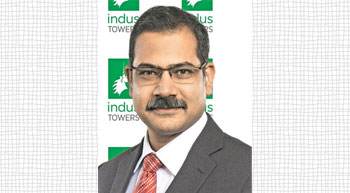Sameer Sinha, Chief Sales and Marketing Officer, Indus Towers, says that smaller and smarter sites will be a focus for Indian telecom tower companies.
To what extent has the industry benefitted ever since it was granted infrastructure status by the government in 2012?
Granting of infrastructure status to the telecom tower industry has resulted in varied financial benefits. External commercial borrowing rates have improved. However, lower import duties and accelerated depreciation benefits are yet to be realised. These benefits are essential for sizeable capital investments by tower companies to partner in the government´s vision of Digital India and Smart Cities.
What will be data´s contribution to the growth in the telecom tower business in the near future?
According to an analyst study, mobile data consumption in India is expected to grow at a CAGR of around 60 per cent from 2016 to 2020. By 2020, data technologies (3G and 4G) are expected to be equally dominant. Industry tenancy ratio is expected to grow from around 1.77 in FY2015-16 to around 2.48 by FY2020, owing to a high focus on data. Network expansion in India is being accelerated through focus on data in urban areas and coverage expansion in semi-urban and rural areas. Data proliferation in urban areas will require dense telecom networks and, consequently, smaller and smarter sites, which will be a focus area for telecom tower companies.
What is the initial impact of the government´s Digital India push on the telecom tower business?
Initiatives like ´Make in India´ and ´Digital India´ have fashioned greater opportunities for operators and manufacturers as well. These have provided an opportunity to infrastructure providers to roll out telecom infrastructure in a planned manner and in collaboration with the government. Liberalising spectrum has also allowed operators to provide 4G and 3G on lower bands across multiple regions. The biggest opportunity is presented by the emergence of new spectrum and broadband data, which creates a spectrum of opportunities across the value chain of equipment vendors, solution providers, content and value-added service application developers, and tower companies. In addition, it is imperative that tower companies take over the task of fibre deployment.
How successful have you been on reducing greenhouse gases emissions?
Indus Towers maintains over 50,000´Green Sites´ in India with over 40,000 sites being non-AC sites. These Green Sites do not consume any diesel and make use of innovative solutions like free cooling units and fast-charging battery banks to reduce energy consumption. Through this, the company has been driving its efforts to reduce its carbon footprint across the country.
As part of its efforts, Indus Towers has been able to successfully reduce 68 per cent of diesel consumption since inception despite the growth in its network.
Furthermore, through its ´Shut AC´ initiative, Indus Towers has converted over 40,000 sites from indoor-to-outdoor (non-AC) by shutting down ACs across the country, resulting in a significant reduction in carbon emission.
How have you gone about addressing the concerns raised around the issue of radiation from mobile towers?
We have always believed in advocating facts based on globally accepted research when it comes to a critical issue like EMF exposure. In India, the EMF exposure limit for the base station emissions was lowered to 1/10th of the standard from October 2012 and, hence, the Indian standards are ten times more stringent than over 90 per cent of the countries in the world. Indus sites are fully compliant with norms laid out by the Department of Telecommunications (DoT). We also play a proactive role in ensuring that all operator companies continue to comply with this standard. We extensively engage with site owners and communities surrounding our sites by distributing educational material, conducting interactive sessions in collaboration with telecom operators and delivering audio-visual messages or presentations. We provide site owners with a customised pre-installation radio frequency level report prior to the start of work. We also provide on-ground support to COAI for its own initiatives for generating awareness covering key stakeholders like RWAs, schools, doctors and media.
How is Reliance Jio´s entry likely to impact the business?
Reliance Jio´s entry is obviously going to cause excitement in the Indian telecom landscape and is likely to expand the data market. This will lead to greater avenues for business opportunities for the telecom infrastructure business. On the telecom operator´s side, it may lead to greater consolidation to compete against the new player.
– MANISH PANT



Leave a Reply
You must be logged in to post a comment.